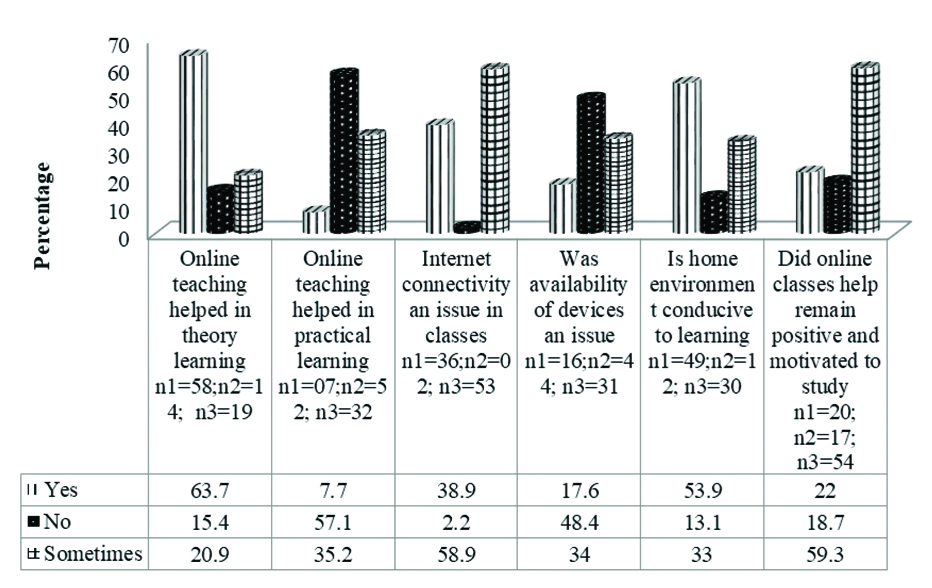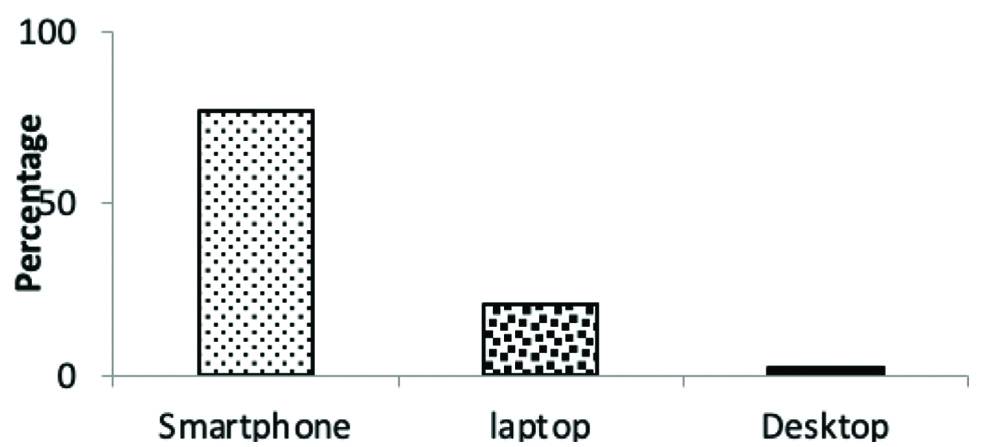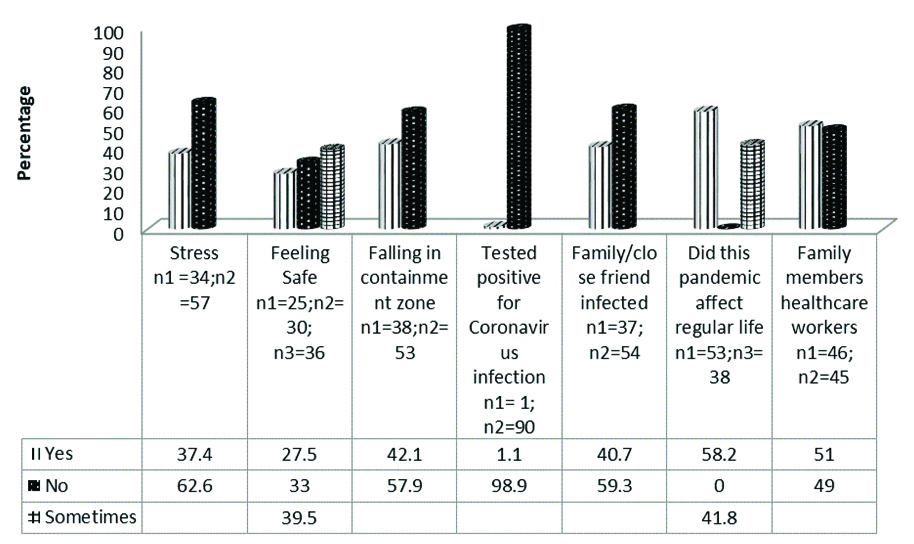Most educational institutes have started E-learning for students to keep up with the academic curriculum [10]. Medical colleges have also followed suit and the medical teaching has shifted from in-classroom to E-learning. In a developing country like India, accessibility to smart phones and computers which is a requisite for E-learning, is still a far fetched idea for many students. Moreover, there are problems with internet connectivity and availability [11]. The academic stress faced by medical students is well-known [12]. This E-learning platform is a new medium for the students also, to add to this first year students have entered the medical course a few months back, so they are facing the dual stress of the exhaustive medical curriculum and coronavirus pandemic. In these very uncertain times, there is also a generalised anxiety and a sense of loss of safety for most of the population. Some previous studies have documented the adverse effects of coronavirus pandemic on students’ mental health status [13,14].
Keeping this background in consideration, the present study was done with an aim to assess the stress status of the undergraduate medical students in regard to the coronavirus pandemic and their perception of the value of E-learning and the challenges that they face in this regard.
Materials and Methods
This was a cross-sectional web-based online survey that was conducted using a questionnaire. The study was carried out in Hamdard Institute of Medical Sciences and Research, New Delhi, India in August 2020. A questionnaire with 20 questions was administered via Google forms, using convenient sampling to all the 100 students of first year MBBS course. The study was conducted after getting approval from the Institute Ethical Committee, Jamia Hamdard, New Delhi, India.
The institute had already moved to E-learning to continue to impart undergraduate medical education. Online teaching in Physiology was started using the Zoom platform and Power Point Presentations (PPTs) of the lectures were provided to class in the end. For practical teaching, videos of the procedures were shared with the class. The students were encouraged to clear their doubts with the teachers whenever required, in lecture time, or later via call, whatsapp or e-mail. Authors also allocated small group teaching so that better interaction could be possible between the students and teachers.
The questionnaire was reviewed by the involved faculty members of the project who were also conducting E-learning sessions and it was approved by faculty from Department of Psychiatry of Hamdard Institute of Medical Sciences and Research, New Delhi, India. A pilot study was first done by first sending the Google form to 10 first-year M.Sc. students of the same University for whom also the online classes were being conducted by our department; in this pilot study the Cronbach’s alpha value was 0.89, so authors proceeded for the data collection from the study population.
The questionnaire was sent via google form to first year MBBS students on their batch common E-mail account on 20th August and the responses were accepted till 25th August 2020. The questions were Multiple Choice Question (MCQ) type with defined options to choose from and were in English language. Some of the questions in the questionnaire were framed to assess the stress status; some were designed to study the students’ perception of E-learning. The students were asked to respond to the questionnaire based on the online teaching being conducted by the Department of Physiology.
Inclusion criteria: Study participants were first year MBBS students who had volunteered to participate in the study. Students were briefed about the study at the end of one of the regular Physiology lecture online sessions being conducted by the investigators. Participation was voluntary and complete anonymity of students’ responses was ensured.
Exclusion criteria: Students who had given history of any mental illness, acute physical illness like appendicitis, pancreatitis etc., or chronic physical illness like diabetes, hypertension etc., or any history of substance abuse were excluded from the study.
Out of all the 100 students of first year MBBS to which the questionnaire was mailed authors received 95 responses (response rate was 95%), four students admitted to be suffering from mental illness and so their responses were not included. Data was collected from rest of the 91 respondents and was compiled using spreadsheets.
Statistical analysis
Data was represented as the percentage distribution of response for each question.
Results
This study was done on a small group of medical students of first year MBBS in the institute. Out of the 91 participants in the study, 48.4% were males (n=44) and 51.6% were females (n=47).
Online teaching: In response to whether online teaching was helping in Physiology theory learning, 63.7% respondents said yes, 20.9% said sometimes while 15.4% responded in negative [Table/Fig-1]. Regarding benefit of online teaching helping in Physiology practical learning, only 7.7% students responded with yes, 35.2% students responded sometimes while 57.1% felt that it was not beneficial. Total 38.9% students reported internet connectivity issues all the time while 58.9% faced the problem sometimes. This was a sizeable percentage of the class population; only 2.2% students said that internet connectivity was never a hinderance in smooth conduction of classes. In regard to availability of devices for attending online classes, 17.6% of students responded that this was an issue, 34% said that sometimes accessibility to device was an issue while 48.4% never had such difficulty. Around 53.9% participants described their home environment conducive to attend online classes, 33% students felt that sometimes their home environment was conducive and 13.1% students did not find their home environment appropriate to attend online classes. For the question whether online classes helped them to remain positive and motivated to study, 22% students have responded yes, 59.3% have responded sometimes and 18.7% students have responded no [Table/Fig-1].
Students’ perception of online classes and associated factors (in%).
Graphs representing percentage distribution of responses as yes, no and sometimes for questions related to effectiveness of online teaching and associated factors; n=number of responses, n1=Yes, n2=No, n3=Sometimes

Duration of online class: Majority of the class 70.3% (n=64) found 45 minutes to be the ideal duration of the online sessions, 26.4% (n=24) students selected 30 minutes and 3.3% (n=3) students selected 60 minutes as ideal duration of online session [Table/Fig-2].
Students opinion of ideal time duration for online class (in%).

Devices: Regarding the question on the device that they were using to attend online classes, the responses for smartphones, laptops and desktops were 76.9%, (n=70) 20.9% (n=19) and 2.2% (n=2), respectively [Table/Fig-3].
Device being used for attending online classes (in%).

Stress: Due to coronavirus pandemic, 37.4% of students reported to be under stress while 62.6% have responded in negative. In response to feeling safe in terms of their health in context of coronavirus pandemic, 33% reported not feeling safe, 39.5% reported feeling safe some of the times while 27.5% felt safe. A 42.1% students reported to their homes falling in containment zone. All students agreed to the fact that this pandemic has affected their regular life, in response to whether the pandemic has affected their regular life, 58.2% students chose yes and 41.8% students chose sometimes as the option. Total 51% of students had their family members as healthcare workers. A major percentage of class, 40.7% had family or close friend infected with disease. Only 1.1% of students reported getting infected themselves [Table/Fig-4].
Students perception of COVID-19 related stress factors (in%).
Graphs representing percentage distribution of responses as yes, no and sometimes for questions related to COVID-19 pandemic related stress factors; n=number of responses, n1=Yes, n2= No, n3=Sometimes

Discussion
The coronavirus pandemic has brought an unprecedented challenge as all teaching institutes had to shift to the online mode. The sudden transition from in-campus learning to exclusively distance learning was challenging for both faculty and students and required a lot of preparation and other efforts in a short time. Nearly all educational institutions, from the lowest to the highest grade have altered their teaching method and shifted to online mode [15,16]. Earlier also innovative solutions have emerged whenever such problems arose during Severe Acute Respiratory Syndrome (SARS) and Middle East Respiratory Syndrome (MERS) outbreaks using telephone and virtual environment [17,18] and other adaptations during COVID-19 [19].
The silver lining in this situation is that there are now more technical tools to facilitate distant learning even when billions of the world population is in lockdown [20]. However, there are several factors that determine the effectiveness of online education, with: a) academic skills; b) technical skills; c) cost and internet access; d) time and motivation for studies; and e) technical issues, being some of them [21].
In the present study, in response to online teaching helping in Physiology theory learning, 63.7% said yes and 20.9% said sometimes. Similarly, Kay D and Pasarica M have documented that online lectures provide high levels of engagement in medical education [22]. Regarding benefit of online teaching helping in Physiology practical learning, 7.7% students responded with yes and 35.2% students answered sometimes; this is understandable as it is not possible for students to acquire the practical skills fully without doing it themselves. Even though the practicals were demonstrated using videos of procedure, they cannot compensate for the experience of doing the practical by oneself. Simulation-based learning via virtual reality or game-like environments has been suggested to improve online curricula [23], something similar is needed to help students learn their practicals in the online mode.
Qureshi IA et al., have described the challenge of non-availability of face to face interaction in online teaching [24]. Armstrong P et al., have reported lack of in-depth group discussion in online learning for clarification of complex topics [25].
Around 38.9% students reported internet connectivity issues all the time while 58.9% faced the problem sometimes which formed a sizeable percentage of the class population. Difficulty in accessibility to devices was present in 17.6% of students and 76.9% of students were using. In a study done by Shetty S et al., students themselves gave the feedback that accessing online classes on mobile was sometimes distracting them as they felt the urge to access social media, check messages, answer calls while using mobile phones which leads to loss of interest and attentiveness during the class [26]. Most students admitted to issues like internet connectivity, accessibility to devices and availability of ideal environment for attending classes from home. These findings agree with the internet and device related issues in India [11].
Due to coronavirus pandemic, 37.4% of students have reported to be under stress. Around 33% reported feeling unsafe all the time while 39.5% felt unsafe some of the times. Steps should be taken to ensure more interaction between the students and the teachers to help the students cope with this difficult time. In a study by Gewin V, author has suggested that course material should also be provided to students to support their online learning [27]. Gallagher TH and Schleyer AM have also documented the medical students’ anxiety about personal safety [28]. Universities should provide psychological support to students for coping with the pandemic [13]. Effective communication is the need of the hour between students and faculty. Gishen F et al., have also concluded in their study that in this pandemic and online teaching time, students should be well-supported practically and emotionally [29].
All the respondents agreed that this pandemic affected their regular life (58.2% responded yes and 41.8% responded sometimes). Eighty one percent of the students felt that online classes have helped them to remain positive and motivated to study rather than leaving students to do their studying themselves, online teaching guides students learning. Dwivedi D et al., have documented that online teaching has yielded a significant impact in decreasing the psychosocial trauma and anxiety the student community is facing [30]. Previous study by Al Ateeq DA et al., shows high to moderate levels of stress among students during the COVID-19 outbreak and recommends online stress management programs to improve stress and coping strategies, as well as prevent further psychological consequences [31]. There are many problems with online teaching [32]; still it has the potential to substitute in-person lecture and clinical based teaching, particularly during this lockdown of educational institutes. But for the continuation of teaching by the online portal, this would have led to a substantial loss of learning time for students.
Limitation(s)
There were some limitations to the present study. All the participants were from the first year MBBS batch from one medical college. Further studies which would include a greater number of participants from different batches of different medical colleges are required in this regard.
Conclusion(s)
Students found online teaching more helpful in learning Physiology theory than practicals. Majority of class reported internet connectivity issues. All the responders agreed that this pandemic affected their regular life. Most of the students felt that online classes have helped them to remain positive and motivated to study. Understanding the problems in online teaching is necessary for effectively imparting medical education during this current crisis and it also lays the foundation for teaching during any future disasters.